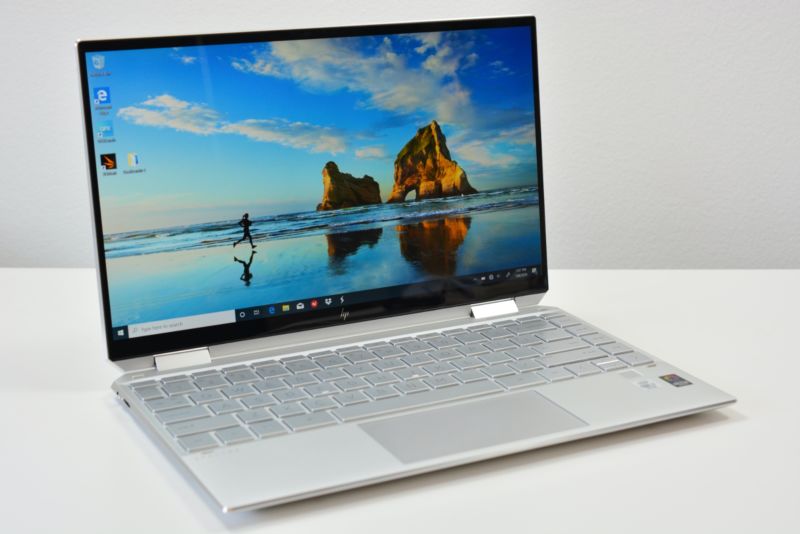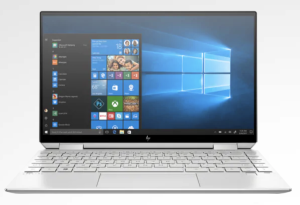
Valentina Palladino
There was a lot to love about the 4th-generation HP Spectre x360 13, but HP wasn’t satisfied. The new 5th-gen laptop, which debuted at the end of 2019, has more improvements than you’d think just by glancing at it. in fact without inspecting it thoroughly, you may think the new Spectre x360 13 looks and feels just like the previous model. But fear not, it’s different—HP significantly shrank the device, added a mic-mute button, gave it optional LTE support, and stuffed 10th-gen Ice Lake Intel processors inside of it.
When OEMs make improvements and try to fix problems on a laptop, they often have to make sacrifices. With thin-and-light flagships like these, sacrifices typically come in power, battery life, and port selection, just to name a few areas. But HP didn’t remove anything from the 4th-generation laptop when making the newest model—a fact that will work in its favor as it has to compete with the likes of the Dell XPS 13 two-in-one and the new Dell XPS 13 laptop. But just how much better did HP make the Spectre x360 13, and are there any hidden negatives about the newest iteration? We recently spent a few days with the laptop to find out.
Look and feel
| Specs at a glance: HP Spectre x360 13 (2019, as reviewed) | |
|---|---|
| Screen | 13.3-inch FHD (1920 x1080) WLED touchscreen |
| OS | Windows 10 |
| CPU | Intel Core i7-1065G7 (Ice Lake) |
| RAM | 8GB |
| Storage | 512GB PCIe SSD + 32GB Optane Memory |
| GPU | Intel Iris Plus Graphics |
| Networking | Intel Wi-Fi 6 AX 201 (2×2), Bluetooth 5 |
| Ports | 2 x Thunderbolt 3, 1 x USB-A, 1 x microSD card, 1 x headphone jack |
| Size | 12.1×7.7×0.7 inches |
| Weight | 2.88 pounds |
| Battery | 60Whr 4-cell |
| Starting price | $1,099.99 |
| Price as reviewed | $1,299.99 |
| Extras | Camera kill switch, mic-mute button, optional LTE, active pen included |

HP Spectre x360 13
If you spend an inordinate amount of time around laptops like I do, the new narrowness to the 5th-gen HP Spectre x360 13 would immediately strike you. The previous model had chunky black bezels at the top and bottom of its display, increasing the overall width of the device. HP slashed most of that unnecessary space here, leaving behind a modest bezel at the bottom of the display with the HP logo on it. The company developed a super-tiny (2.2mm) IR camera as well, so it could keep that form of Windows Hello on the shrunken top bezel.
The higher screen-to-body ratio is great to see, but HP is still using a panel with a 16:9 aspect ratio. That means a lot more scrolling than necessary, and it makes me wish that HP looked at the previous version of the Spectre x360 13 in a different way. Instead of abolishing the top and bottom bezels entirely, the company could have instead put a 3:2 aspect ratio screen on the laptop and removed any excess bezel that surrounded it. The final design wouldn’t be as narrow as this new model is, but it would have given users a more practical display.
The display options are typical of a flagship laptop like this: there’s an FHD touchscreen, an FHD panel with HP’s SureView privacy filter, and a 4K OLED panel that will surely be enticing but will likely be overkill for most. The FHD touchscreen on my review unit was lovely to use, although it did suffer from glare when angled toward open windows and while in the pathway of direct sunlight. Only display enthusiasts and creatives will actually get practical use out of a 4K OLED panel, and they must be willing to sacrifice some battery life in order to get it.
Privacy and ports
The camera kill switch sits on the right side of the laptop, and it’s now accompanied by a mic-mute button on the keyboard. The camera switch electronically cuts off power to the webcam, so similarly to a webcam shutter, it’s a good feature to have for those who want more control over their privacy. The only bad thing about it is that the webcam and the IR camera are connected, so if you flip the kill switch, you won’t be able to use the IR camera for Windows Hello. In addition to the IR camera, passwords, and pins, though, the Spectre x360 13 also has a fingerprint reader on its right palm rest that you can use to unlock the machine.
The edges of the Spectre x360 13 are thicker than you may expect, and that’s mostly due to its gem-cut style. It’s thicker than the Dell XPS 13, but that actually helps HP’s laptop because it can fit one or two more ports than Dell’s laptop. Next to the camera kill switch is the microSD card slot and two Thunderbolt 3 ports, one on the flat edge and one on the corner (one on each side would have been preferred for convenient charging purposes, but we can’t get everything we want). The corner on the left side holds the power button, and next to that are a headphone jack and a drop-jaw USB-A port.
Dell continues to produce XPS 13s without USB-A ports, and that likely will never change. But we’re still a bit far off from USB-A being totally taken over by USB-C, so it’s useful to have on any laptop. It’s reassuring that HP didn’t try to go as thin as it possibly could on the Spectre x360 13 (like it did on the Elite Dragonfly), but, rather, the company kept a bit of heft in order to keep a valuable port on the machine.









